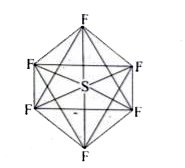Explain VSEPR theory . Applying this theory to predict the shapes of IF7, and SF6.Solution in Tamil
(i) The shape of the molecules depend on the number of valence shell electron pair around the central atom.
(ii) i) There are two types of electron pairs namely, bond pairs and lone pairs.
(iii) Each pair of valence electrons around the central atom repel each other and hence they are located as far away as possible in three dimensional space to minimise the repulsion between them.
(iv) The repulsive interaction between the different types of electron pairs is in the following order:
lp−lp>lp−bp>bp−bp
lp : lone pair, bp : bond pair
(v) The lone pair of electrons are localised only on the central atom and interact with only one nucleus whereas the bond pairs are shared between two atoms and they interact with two nuclei. Because of this, the lone pairs occupy more space and have greater repulsive power than the bond pairs in a molecule.
IF7 : It is an AB7 type molecule. This molecule has 7 bond pair of electrons and no lone pair of electrons. Due to bond pair-bond pair interaction of electrons, IF7 has pentagonal bipyramidal shape.

SF6: It is an AB6 type molecule. This molecule has 6 bond pairs of electrons and no lone pair of electrons. Due to bond pair-bond pair interaction of electrons, SF6 has octahedral shape.

Topper's Solved these Questions
- BOOK - FULL MARKSCHAPTER - CHEMICAL BONDING EXERCISE - IN TEXT QUESTION-EVALUATE YOURSELF10videos
CHEMICAL BONDING
- BOOK - FULL MARKSCHAPTER - CHEMICAL BONDING EXERCISE - ADDITIONAL QUESTIONS SOLVED (CHOOSE THE CORRECT ANSWER.)50videos
CHEMICAL BONDING
- BOOK - FULL MARKSCHAPTER - CHEMICAL BONDING EXERCISE - ADDITIONAL QUESTIONS SOLVED (5-MARK QUESTIONS)14videos
CHEMICAL BONDING
- BOOK - FULL MARKSCHAPTER - BASIC CONCEPTS OF ORGANIC REACTIONS EXERCISE - Additional Questions Solved (5-Marks Question)10videos
BASIC CONCEPTS OF ORGANIC REACTIONS
- BOOK - FULL MARKSCHAPTER - ENVIRONMENTAL CHEMISTRY EXERCISE - ADDITIONAL QUESTIONS SOLVED ( 5-Mark Questions )8videos
ENVIRONMENTAL CHEMISTRY
Similar Questions
Draw the lewis structures for
(i) Nitrous acid (HN02) (ii) Phosphoric acid (iii) Sulphur troxide (SO3)12:01View SolutionWhich is the correct Lewis structure of Helium?
09:26View SolutionExplain about Kossel-Lewis approach to chemical bonding.
View SolutionExplain electron movement in organic reactions.
02:14View SolutionExplain about the different layers of Earth's atmosphere
View SolutionPredict the shapes using VSEPR theory, IF7,ClF3,SF6,BeCl2.
04:08View SolutionExplain VSEPR theory . Applying this theory to predict the shapes of IF7, and SF6.
09:31View SolutionOn the basis of VSEPR theory predict the shape of the Ozone .
04:55View SolutionPredict the shape of ClF_(3) according to VSEPR theory.
07:30View SolutionApplying VSEPR theory, how to predict the shape of IF7?
03:39View SolutionVSEPR सिद्धान्त के आधार पर निम्नलिखित अणुओं की आकृतियाँ बताइए: (i) CIF3 (ii) BrF5 (iii) IF7
04:32View SolutionVSEPR theory is used to predict the shape of covalent molecules .
a) State the main postulates of VSEPR theory04:41View SolutionVSEPR theory is used to predict the shape of covalent molecules .
b) Based on VSEPR theory predict the shape of H2O and NH3.02:51View SolutionVSEPR theory is used to predict the shape and bond angle of molecules. a) Write the postulates of VSEPR theory.
02:08View SolutionVSEPR theory is used to predict the shape and bound angle of molecules. b) Explain the shape and bond angle of NH_3 molecule using VSEPR theory.
02:47View Solution

